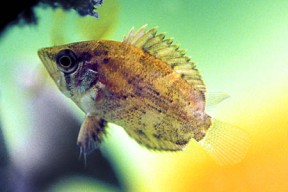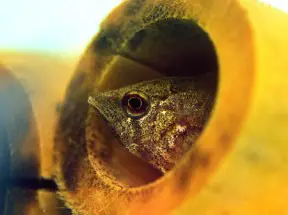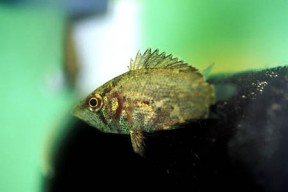Polycentropsis abbreviata
African Leaf Fish
Classification
Nandidae
Distribution
Cameroon, Benin, Gabon, Nigeria.
Habitat
It inhabits pools, swamps, creeks and slow-moving rivers. It occurs most frequently in areas of submerged vegetation around the banks of these.
Maximum Standard Length
3.2″ (8cm).
Aquarium SizeTop ↑
24″ x 15″ x 12″ (60×37.5x30cm) – 70 litres.
Maintenance
Soft acidic water is essential. The aquarium should be dimly-lit with floating plants in order to diffuse the light further. Heavy planting with large-leaved varieties such as Echinodorus species, as well as some hiding places in the form of driftwood, are also recommended to make this fish feel secure as they can be very nervous. Any water movement should be kept to a minimum.
Water Conditions
Temperature: 79-88°F (26-31°C)
pH: 6.0-6.5
Hardness: 1-10°H
Diet
It is carnivorous and often will only accept live food. Bloodworm and small earthworms are good choices. Some specimens can be trained to accept dead alternatives but will only feed on items that are moving through the water column. Although it is highly piscivorous in nature, there is no need to feed P. abbreviata live fish in the aquarium.
Behaviour and CompatibilityTop ↑
A species tank is highly preferable, although it can be kept with medium-sized loricariids and armoured catfish without too many problems. Other quiet species which are too large to be eaten, such as gouramis, Ctenopoma and West African dwarf cichlids are also possibilities. Small fish will certainly be eaten.
It is possible to maintain a small group of this species in a suitably large tank, as it is not particularly aggressive towards conspecifics.
Sexual Dimorphism
Not an easy fish to sex. According to Baensch, females have a convex ventral line, which is straight in males, but this is unconfirmed. When the fish are spawning the female takes on a lighter patterning.
Reproduction
Rarely achieved in captivity. Bubble nester. Apparently, the fish can be induced to breed by providing dense planting, especially around the surface, and lowering the water level to 4-6″. The tank should be warm (above 77°F) and dimly-lit. It is best to select a single pair of fish, and these should be conditioned with plenty of live foods.
It is the male who builds the bubblenest, situating it amongst the surface vegetation. He may construct several nests prior to spawning. The act itself is quite a vigorous affair and the pair may deposit over 100 eggs into the bubble nest. The eggs hatch in 48-72 hours and should be fed live foods such as brine shrimp nauplii from birth. It is advisable to remove the parents once the eggs have hatched, or they may predate on the fry. The maintenance of high water quality is essential as the young are very sensitive to deteriorating water quality.
NotesTop ↑
Like the closely related Polycentrus species from South America, with which it is sometimes confused, this fish is camouflaged to mimic a dead leaf, both in body shape and pattern. It can also change colour to match its surroundings. When hunting, it stalks its prey in a head-down stance, appearing to drift towards it like a dead leaf drifting in a current. In reality the fish is propelled by tiny movements of its transparent hind fins.
When it strikes at an item of prey, the entire mouth protrudes outwards, forming a tube into which the prey is sucked, usually head first. This happens so quickly it is often difficult to see. It can swallow prey almost as big as itself in this way.
It is quite rare in the hobby, and is not the easiest fish to maintain in captivity. It is therefore not recommended for the beginner. In addition to being a voracious predator, P. abbreviata is also a somewhat flighty species that is very sensitive to deteriorations in water quality.




